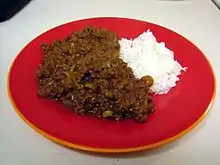Picadillo
Picadillo (Spanish pronunciation: [pikaˈðijo], "mince") is a traditional dish in many Latin American countries including Mexico and Cuba as well as the Philippines. It is made with ground meat (most commonly beef), tomatoes (tomato sauce may be used as a substitute), and also raisins, olives, and other ingredients that vary by region.[1] It is often served with rice (hence it is commonly known in the Philippines as arroz a la cubana, "Cuban-style rice") or used as a filling in dishes such as tacos, savory pastries or croquettes. The name comes from the Spanish word picar, meaning "to mince".[1]

Picadillo can be eaten alone or incorporated into other dishes, like tacos, empanadas, pastelón, chiles en nogada, or alcapurrias.[2]
History
Although the dish was common in Hispanic cultures before the 19th century, a 19th-century recipe from California for pasteles a la argentina is given for a filled pastry with layers of beef picadillo and chicken cooked in a green chili and onion sauce with olive oil and raisins. "Picadillo" was not always made with beef; "picadillo de ave" was a minced fowl with white sauce. Pasteles de pollos y pichones (chicken and squab pastry) was made as a savory pie with alternating layers of chicken and squab with a picadillo of minced veal, bacon, ham fried in lard with onion, mushrooms, apples, artichokes, tomatoes, and a layer of seasonings.[3]
By region
Costa Rica
Costa Rican versions always include the name of the vegetable that represents the main ingredient to the dish (potato picadillo, ayote picadillo, etc.) and that is chopped and cooked with bell peppers, onions, stock, herbs and spices. It can include some type of protein but that is not essential. It is often served with tortillas or rice.
Cuba
Cuban versions include peppers, onions, garlic, oregano, cumin, tomato sauce, stock, olives, and on occasion potatoes, capers,[1] and Spanish chorizo[4] and is usually sauteed in olive oil and white wine, depending on the region. Cuban picadillo is served with black turtle beans and rice.[5]
Dominican Republic
In the Dominican Republic it includes peppers, onions, cilantro, garlic, tomato paste, bouillon cube, and may include olives, capers, raisins, hard-boiled egg. It is served over rice or used as a filling for pasteles, empanadas, kibbeh, and cabbage rolls.
Puerto Rico
In Puerto Rico it is used as a filling for empanadas, alcapurria, piononos and other fritters. It can also be served with rice and beans. The ground meat is sauteed with annatto, diced ham, oregano, bay leaf, recaito, tomato sauce and on occasion cumin, cheese, raisins, beans, sweet peas, olives, capers, diced potato, other spices and herbs. Puerto Rican Picadillo[6] does vary from family to family.
Philippines
In the Philippines, picadillo is a soupy dish traditionally made with ground beef and either potatoes or chayote. There are also drier versions of the dish. It is also called giniling. Cubans call picadillo arroz a la cubana. In Cuba, arroz a la cubana and picadillo are understood as separate dishes instead of the same, with the former being rice cooked in tomato sauce and served with egg and plantain. The Philippine version is similar to normal Latino picadillo usually made with raisins, tomato sauce and diced potatoes added, but without green olives and capers, and is often served with white rice, fried plantains (maduros in Spanish, saging na saba in Filipino) on the side, and a fried egg on top. Boiled eggs are also eaten with the dish.
Mexico

In Mexico, beef picadillo is a classic antojito of the national cuisine.[7][8] The most basic and popular set of ingredients of picadillo in Mexico are ground beef, carrots and potatoes, all cooked in a tomato sauce made from blended tomatoes, garlic and onion, usually seasoned with salt, pepper, and cumin but its preparation and ingredients can vary slightly from one region to another. For example, a Mexican picadillo can also include squash or peas. Mexican picadillo is typically eaten with tortillas, tostadas or tortilla chips and usually accompanied with rice or beans. It can be used as filling for chiles rellenos,[9] chiles en nogada,[10] tamales[11] or gorditas.[12][13][14] Pork is also a popular meat to use for picadillo in Mexico, as well as a mixture of pork and beef.[15][16]
See also
References
- Sifton, Sam (17 September 2014). "The Ultimate Cuban Comfort Food: Picadillo". New York Times. Retrieved 7 December 2018.
- Galarza, G. Daniela (February 2021). "For dinner, go for a peak picadillo". Washington Post. p. 3AD. Retrieved 23 February 2022.
- El cocinero español by Encarnación Pinedo, 1898
- Bremzen, Anya Von "Picadillo a la Habanera" Paladares: Recipes inspired by the private restaurants of Cuba" (2017, ISBN 978-1-4197-2703-0) p. 248-249
- "Cuban Picadillo".
- Rivera, Rachel (2020-08-10). "Puerto Rican Picadillo Recipe - thecleanhappylife". Retrieved 2023-08-02.
- "Picadillo de res, recetas rápidas de cocina mexicana ⋆ Larousse Cocina". Larousse Cocina (in European Spanish). Retrieved 2022-04-19.
- "Cómo hacer picadillo mexicano". Comedera - Recetas, tips y consejos para comer mejor. (in Spanish). 2018-12-28. Retrieved 2022-04-19.
- "Chiles Rellenos de Picadillo, receta con imágenes paso a paso. Muy fácil". Recetas de comida mexicana | México en mi Cocina. 2017-05-20. Retrieved 2022-04-19.
- "Qué ingredientes llevan los chiles en nogada". El Universal (in Spanish). 2020-07-30. Retrieved 2022-04-19.
- "Tamales de picadillo de cerdo". Comida Kraft (in Spanish). Retrieved 2022-04-19.
- admin (2020-11-13). "🔸Gorditas De Harina De Picadillo Norteño ⋆ Cocina Con Sazón". Cocina Con Sazón (in Spanish). Retrieved 2022-04-19.
- "Picadillo mexicano". www.guiadelacocina.com (in Spanish). Retrieved 2022-04-19.
- "Picadillo". mx.recepedia.com (in Mexican Spanish). Retrieved 2022-04-19.
- "Picadillo Mexicano de Puerco". www.mexican-authentic-recipes.com. Retrieved 2022-04-19.
- Soco, Mary (2017-06-29). "Picadillo de cerdo con verduras. Receta de cocina mexicana". Directo al Paladar México (in Spanish). Retrieved 2022-04-19.




.jpg.webp)




_01.JPG.webp)
